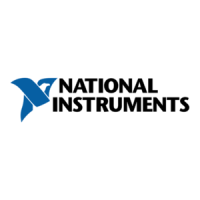
Do you have a question about the National Instruments DAQ Series and is the answer not in the manual?
| Device Type | Data Acquisition (DAQ) |
|---|---|
| Series | DAQ Series |
| Manufacturer | National Instruments |
| Category | Recording Equipment |
| Input Channels | Varies by model (e.g., 8, 16, 32, etc.) |
| Sampling Rate | Varies by model (e.g., 100 kS/s, 1 MS/s, etc.) |
| Resolution | Varies by model (e.g., 12-bit, 16-bit, 24-bit) |
| Interface | USB, PCI, PXI, Ethernet |
| Software Compatibility | LabVIEW, MATLAB |
Details the warranty terms and conditions for the DAQCard-700.
Information on copyright laws, trademarks, and product names.
Critical warnings regarding the use of National Instruments products in specific applications.
Explains typographical and symbolic conventions used throughout the document.
Guides users on which NI documentation to consult for different aspects of the system.
Overview of the DAQCard-700 features, low-cost, low-power AI, DIO, and TIO card.
Lists essential hardware and software required for setup and operation of the DAQCard-700.
Discusses using NI-DAQ with various Application Development Environments (ADEs).
Explains NI-DAQ's role, functions, and consistent software interface for DAQCard-700.
Details LabVIEW and Measurement Studio as development environments for DAQ applications.
Information and guidelines for designing and using custom cables with the DAQCard-700.
Instructions on how to unpack the DAQCard-700 safely and check for damage.
Important safety precautions and guidelines for installing and using the DAQCard-700.
Steps for installing the Application Development Environment (ADE) and NI-DAQ.
General instructions for physically installing the DAQCard-700 into a PCMCIA slot.
Overview of software configurability for AI coupling, range, and other settings.
Details on default AI configurations and available settings for analog input.
Explains the two input modes: RSE (Referenced Single-Ended) and DIFF (Differential).
Describes the configuration for digital input and output ports on the DAQCard-700.
Information on using the MSM82C54 for general-purpose applications and timing.
Details the pin assignments and general setup for the DAQCard-700 I/O connector.
Provides detailed descriptions of each pin on the DAQCard-700 I/O connector.
Guidelines for connecting analog input signals to the DAQCard-700, including AIGND and ACH pins.
Discusses ground-referenced and floating signal sources for proper measurement.
Describes ground-referenced and floating measurement systems for context.
Explains how to configure the DAQCard-700 for DIFF or RSE input modes.
Details the RSE input mode, its operation, and its use for 16 AI channels.
Explains the DIFF input mode, its operation, and its use for 8 AI channels.
Summarizes recommended input configurations for different system and signal types.
Criteria and considerations for using single-ended connections with RSE mode.
Illustrates how to connect signal sources using single-ended mode.
Discusses conditions for using DIFF mode and its benefits for noise reduction.
Shows how to connect grounded signal sources using DIFF input mode.
Illustrates connecting floating signal sources using DIFF input mode with bias resistors.
Explains common-mode rejection and calculations for the DAQCard-700.
Guidelines for connecting digital input and output signals to the DAQCard-700.
Provides examples of connecting digital signals, including TTL and LEDs.
Details the +5 V power pin and its current limitations.
Information on connecting TIO signals and using the MSM82C54 counter/timers.
Explains using counter 0 or EXTCONV* for timed A/D conversions.
Discusses using GATE, CLK, and OUT signals for counter applications.
Provides a block diagram and overview of the DAQCard-700's functional components.
Explains the architecture of the PCMCIA interface for data transfer and control.
Details the AI channels, ADC, and FIFO buffer for data acquisition.
Describes the input multiplexer, gain stage, and ADC for analog signal processing.
Explains how clocks and timing signals manage data acquisition intervals.
Describes the process of acquiring data from a single analog channel.
Explains scanning multiple channels for data acquisition.
Discusses factors limiting data acquisition speed and accuracy.
Details the digital input/output lines and registers for TTL compatibility.
Explains the use of the MSM82C54 counter/timer for timing and general I/O.
Lists key input characteristics like channels, resolution, sampling rate, and ranges.
Details accuracy, DNL, and offset/gain errors of the ADC.
Specifies input impedance and CMRR for the instrumentation amplifier.
Covers settling time and system noise for the DAQCard-700.
Information on warm-up time and onboard calibration reference.
Specifications for digital input and output channels and compatibility.
Specifications for counter/timer channels and compatibility.
Defines voltage levels for digital signals used with the MSM82C54.
Specifies the power consumption and voltage requirements of the DAQCard-700.
Details the physical form factor, PC Card type, and connector type.
Defines maximum working voltages for channel-to-earth and channel-to-channel.
Lists operating and storage temperature, humidity, and altitude limits.
Lists safety standards met by the DAQCard-700.
Details CE, C-Tick, and FCC compliance for emissions and immunity.
Summarizes key functional differences between the DAQCard-700 and PC-LPM-16.
Addresses common questions related to installing and configuring the DAQCard-700.
Answers common questions about operating the DAQCard-700, including differential input issues.
Information on accessing online support resources for installation and troubleshooting.
Resource for learning about measurement and automation systems and sharing techniques.
Information on training options, courses, and schedules offered by NI.
Details on consulting and system integration services from NI Alliance members.
Defines common prefixes used in scientific and technical contexts.
Lists common numbers and symbols with their meanings.